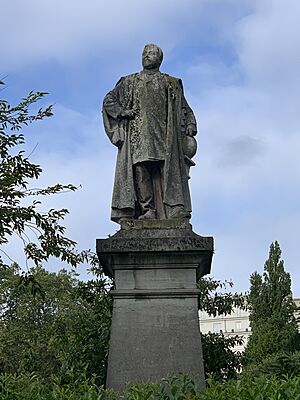Alphonse François Renard facts for kids
Alphonse Francois Renard (born September 27, 1842 – died July 9, 1903) was a famous Belgian geologist. Geologists are scientists who study the Earth's rocks, minerals, and landforms. Renard was also a petrographer, which means he specialized in studying rocks under a microscope. He was born in Ronse, a town in Belgium.
Contents
Early Life and His Path to Science
Alphonse Renard first studied to become a priest in the Catholic Church. From 1866 to 1869, he worked as a leader at the college de la Paix in Namur.
In 1870, he joined the Jesuit Training College at Maria Laach Abbey. This old abbey was in a volcanic area called the Eifel. While studying philosophy and science there, he became very interested in the local geology. He was especially fascinated by the volcanic rocks around him. This sparked his passion for science. From then on, he focused on learning about chemistry and mineralogy. These studies helped him become an expert in examining rocks.
A Career in Geology
In 1874, Renard became a professor of chemistry and geology at a college in Leuven, Belgium. A few years later, he also became a curator at the Royal Natural History Museum in Brussels. A curator helps manage and care for a museum's collections. In 1882, he left his teaching job at Leuven to focus more on his museum work.
In 1888, he was chosen to be a geology professor at the University of Ghent. He kept this job for the rest of his life. Even though he had been ordained as a priest in 1877, he later decided to leave the church. He wanted more freedom to explore his scientific ideas.
Amazing Discoveries with the Challenger Expedition
Alphonse Renard did a lot of important research on rocks. His first major work was about the types of rocks found in Belgium and France. He studied how different rocks were formed and what minerals they contained. He also looked at how rocks change over time, a process called metamorphism.
In 1885, he received the Bigsby Medal from the Geological Society of London. This was a big award for his excellent work.
Even more important were his studies related to the Challenger Expedition. This was a famous scientific journey around the world by a ship called HMS Challenger. Scientists collected many rock samples and mud from the deep ocean floor. Renard worked with Sir John Murray to study these samples. Their detailed findings were published in a large report in 1891.
Their discoveries were truly amazing:
- They found and described tiny particles of cosmic dust. This dust slowly falls from space and settles on the ocean floor.
- They observed how special crystals called zeolites grew on the seabed. These crystals formed even in very cold water, near 0°C (32°F).
- They mapped where manganese nodules were found. These are small, lumpy rocks rich in manganese and other metals. They also studied deposits of phosphate and glauconite on the ocean bed. These are minerals that form in the ocean.
Alphonse Renard passed away in Brussels on July 9, 1903.
Legacy
Alphonse Renard is remembered for his important contributions to geology. A street in western Ixelles, a part of Brussels, is named Rue Alphonse Renard in his honor. Also, a mineral discovered in 1928 was named renardite after him.
See Also
- Geology
- Petrography


